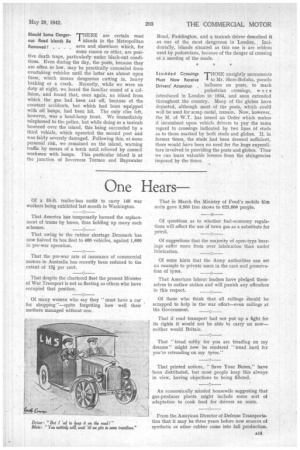Passing Comments
Page 16

Page 17

If you've noticed an error in this article please click here to report it so we can fix it.
Tyres of Wood Faced A N important bakery corn
with Brake Friction pany, Dugan Bros.. of New Material Jersey, Inc., operating 1,200 motor vehicles, is experimenting with tyres made of hard wood surfaced with brake friction material. Daily tests have been carried out, and it is said that the results, so far, have been • satisfactory. The tyres are made in four sections to facilitate removal and repair, and the material is riveted to the surface, At 25 to 30 m.p.h., the steering is as easy as on pneumatic tyres, and the vehicle rides smoothly on good roads. Herein lies a possible partial solution of the difficulty caused by the dearth of rubber.
Special Class of URING his speech as Presi
lowing the address by H.R.H.? .
the Duke of Kent at the Association's A.G.M., Major R. A. B. Smith suggested that the road-transport industry should have its own Home Guard. He thought it necessary that transport drivers should be taught to shoot and be equipped to protect a convoy, practically on their own, if necessary. In the eent of invasion they might be able to do much to frustrate the enemy. These men should certainly proceed on their journeys with some knowledge of what they might be called upon to meet and how to deal with the situation.
THERE are . certain road 1 islands in the Metropolitan area and elsewhere which, for some reason or other, are positive death traps, particularly under black-out conditions. Even during the day, the posts, because they are often so low, may be practically concealed from overtaking vehicles until the latter are alruost upon them, which means dangerous cutting in, heavy braking or a crash. Recently, while we were on duty at night, we heard the familiar sound of a collision, and found that, once again, an island from which the gas had been cut off, because of the constant accidents, but which had been equipped with oil lamps, had been hit. The only clue left, however, was a head-lamp front. We immediately telephoned to the police, but while doing so a taxicab bounced over the island, this being succeeded by a third vehicle, which uprooted the second post ,and was fairly severely damaged. Following this, at some personal risk, we remained on the island, warning traffic by means of a torch until relieved by council workmen with lamps. This particular island is at the junction of Inverness Terrace and Bayswater
Should Some Dangerous Road Islands Be Removed
Road, Paddington, and a taxicab driver described it as one of the most dangerous in London. Incidentally, islands situated as this one is are seldom used by pedestrians, because of the danger of crossing at a meeting of the roads.
Studded Crossings THOSE unsightly monuments Must Now Receive I to Mr. Hore-Belisha, pseudo Drivers' Attention . balloons on posts, to mark
pedestrian crossings, were introduced in London in 1934, and soon extended throughout the country. Many of the globes have departed, although most of the posts, which could well be used for scrap metal, remain. Now, however, the M. of W.T. has issued an Order which makes it incumbent upon vehicle drivers to pay the same regard to crossings indicated by two lines of studs as to those marked by both studs and globes. If, in former times, the studs had been deemed sufficient, there would have been no need for the huge expenditure involved in providing the posts and globes. Thus we can learn valuable lessons from the stringencies imposed by the times.




















































